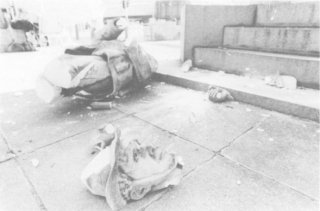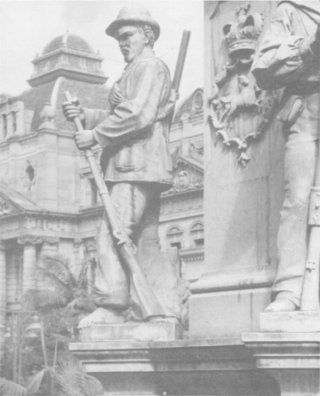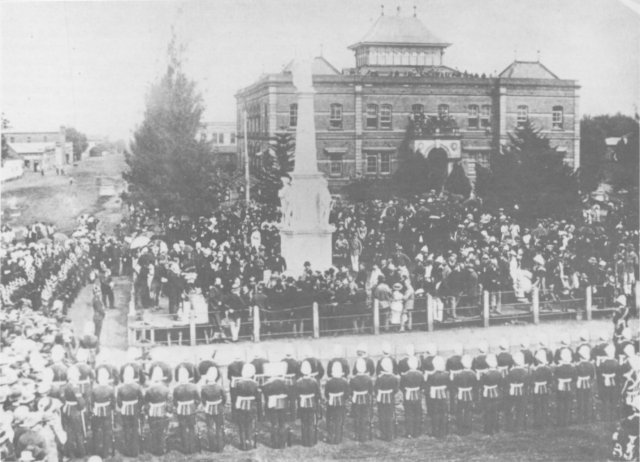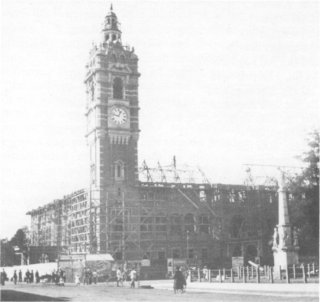

 The South African
The South African
(incorporating Museum Review)
by M Coghlan
KwaZulu-Natal Provincial Museum Service

Smashed into the proverbial 'thousand pieces'
Photo courtesy of The Natal Witness.
For over a hundred years, the memorial stood as an apparently inviolable feature of the Victorian cityscape, so much so that it was not realised until 14 April 1994 that the statues were not secured to their bases.(a) The memorial’s origins lie in the immediate aftermath of the Anglo-Zulu War of January to July 1879, a conflict of immediate interest to white Natal colonists. Twenty-two members of the Natal Carbineers, the colony’s senior regiment, based in Pietermaritzburg, had been killed in the Battle of Isandlwana. It was at a banquet in Alexandra Park on Thursday, 7 August 1879, held to welcome the Natal Carbineers home from the war, that the erection of a memorial was first proposed.(3) As was the case with the Bushmen’s Pass Memorial in the Carbineer Gardens alongside the present City Hall, a memorial committee was established at a private meeting called by a Major P Davis on 4 September to raise funds from the public.(b) The committee’s secretary was Sir Theophilus Shepstone, at that time Administrator of the Transvaal, and it also included the Colonial Secretary, Colonel Mitchell.(4) The raising of the necessary funds proved a lengthy four and a half year process, delayed by the First Anglo-Boer War of 1880-1.
The initial fundamental obstacle was the selection of a site for the memorial. Proposals included a quadrangle at the station and sites opposite the Post Office and Church Street entrance to the Supreme Court.(5) Both the Post Office and the Supreme Court were at the time located in the present Tatham Art Gallery.(c) In August 1882, an application by Shepstone for land on the Market Square was refused. On 3 July the following year permission was secured from the Lieutenant-Governor Sir Henry Bulwer for the use of a plot in the Court Gardens, at a location described as opposite Henderson and McFie’s premises.(7) This incidentally, required the removal of several conifers planted by Colonel Durnford.(8) This matter was resolved just in time, as the imported memorial had been due in Durban on 2 July and the foundation had to be installed timeously.(9) This foundation, twelve feet square with three steps, was of hard white stone from the Jesse Smith quarries in Town Bush Road.(10)
There was considerable debate surrounding the memorial itself, particularly in the form it would take - a charitable institution, church, drinking fountain, an addition to the Bushman’s Pass Memorial, or a separate monument; the latter being decided on.(11) There was no public tender for designs. Instead one of four designs proposed by Mr Rowles, foreman at Jesse Smith and Sons, statuaries and stonemasons (corner of Commercial Road and Loop Street, Pietermaritzburg), was adopted. This design called for a structure 46 feet tall, costing £ 3 000. However, when barely half that amount had been raised by March 1882 it was decided to scale down the design by a third and proceed immediately, rather than delay indefinitely for want of funds.(12) This led to some complications. Initially it appears that the original scale of the pedestal and of the figures was retained while the overall height was reduced to 35 feet. At an unspecified point, it was decided that the proportions of the figures had to be adjusted for more pleasing overall aesthetic appearance. The crowning statue (‘Peace and Victory’) increased in size from 5’6 to 7 feet, and the four lesser statues from 4’6 to 6 feet.(13) The overall cost dropped to £ 1 882, but of this more modest figure, £ 200 was still outstanding at the time of unveiling.
Mr Rowles’ overall design was supplemented by input from a Professor Nicoli Carvara, of Leghorn Italy. All the marble and statuary was also inspected from that country, with the work probably executed under the direction of the professor.(14) The three-ton memorial rose above its stone base in several distinct stages. The initial six foot high pedestal was of blue-veined polished Sicilian marble. The four lifesize figures, representing the participants in the campaign on the British-Colonial side, stood at ease, on the abutting caps of this first pedestal.(15) Facing Church Street stood a Natal Carbineers officer; a British soldier-of-the-Line faced the corner of Church Street and Commercial Road; a sailor of the Naval Brigade faced Commercial Road; and ‘guarding’ the secluded aspect of the memorial facing the Court Gardens was the statue of particular interest to this article. This was supposed to depict a levy of the Natal Native Contingent (NNC), black irregular troops raised in Natal for service, mostly in an ancillary capacity, with the British columns. An examination of the features and equipment of these ‘representatives’ reveals some oddities. The supposed NNC levy, for example, carries a muzzle-loading percussion musket, whereas few of these troops were equipped with firearms. He also has ‘peppercorn’ hair, but a puzzling combination of black and European features.

The statue of the Natal Native Contingent Levy
Photo by courtesy: Dr Paul Thompson
There is no ready explanation other than, possibly, the memorial’s construction and partial design in Italy. A second pedestal rose six and a half feet to the base of a slender obelisk, itself a further twelve feet high and divided into four segments by ornamental bands carved with details of laurel and oak. The memorial was crowned with a winged female symbol of ‘Peace and Victory’, clutching a laurel wreath in an outstretched right hand. The inscriptions on the lower pedestal were set in lead by Jesse Smith at a cost of £ 100.(e) (See Appendix). The memorial was only officially handed over to the colonial government on 21 February l885,(16) eighteen months after its unveiling in October l883.(f)
The day of the unveiling ceremony dawned a humid and unpleasant one, the air ‘laden with unpleasant odours’.(17) Fortunately, in the interval between severe thunderstorms (and a rainstorm) the sun broke through and the event was able to proceed. The selected dignitaries present included the Lieutenant-Governor, Sir Henry Bulwer, Theophilus Shepstone, Dean Green and Archdeacon Colley. There were addresses by Sir Henry Bulwer and the mayor of Pietermaritzburg, Mr H Griffin. The military was present in strength. The imperial garrison at Fort Napier was represented by a contingent of the 2nd Battalion 58th (Northamptonshire) Regiment under the command of a Captain Dickinson, drawn up in Church Street. Behind them stood The Natal Carbineers (Captain William Royston) and a small Natal Mounted Police detachment. Arrayed in Commercial Road were the Maritzburg Rifles (Captain Birkett), with the Edendale Horse (Captain Wyatt Vause) behind them. Although many otherwise absentees turned up when the weather cleared, it was, according to The Natal Witness, a disappointing turnout. This ‘apathy’ was explained as follows: ‘The residents of Pietermaritzburg are not, as a rule, so demonstrative as their more lively coast neighbours. Events which in Durban would cause quite an hysteria are treated very nonchalantly in the capital. It may be that the pomp of gubernatorial movements is so much part of our everyday life, that there is not the novelty in them that there is to the Durban people.’(18)

The unveiling of the Anglo-Zulu War Memorial, Thursday 11 October 1883, from Church Street.
In the background is the current Tatham Art Gallery
(Photo: by courtesy of the Natal Archives Depot)
So, in possibly typical Pietermaritzburg style, the Anglo-Zulu War Memorial seldom made headlines until the unfortunate events of 13 April 1994. In 1901, the now familiar muzzle-loading 12-pounder naval gun was placed at the foot of the memorial(19) and in 1902 a request was received from the Town Clerk of Grahamstown for details of the memorial, presumably as a guideline for their own plans for an Anglo-Boer War memorial.(20) Also, situated in its prominent position in the city centre, the memorial was often the backdrop for parades, ceremonies and protests. In April 1918, for example, the Returned Soldiers League of Pietermaritzburg placed a wreath on the monument as part of efforts to raise recruits for the South African Brigade then fighting in France and it was also a popular location for Black Sash vigils during the l950s.

The naval gun can be seen facing the second City Hall (completed in 1903)
(Photo: Harte Photographic Collection, Natal Carbineers History Centre)
Notes
a. It was difficult to locate a clear photograph of the statue in question prior to April 1994, for restoration purposes, owing to its location on a corner of the memorial facing the Court (now Gallery) Gardens, as it was usually obscured in photographs taken from the street (Commercial Street or Church Road). The close-up photograph by Dr Paul Thompson is therefore of exceptional value.
b. Natal colonial troops, mainly from the Natal Carbineers and Karkloof Carbineers, had suffered a sharp reverse at the Bushman’s River Pass in the Natal Drakensberg on 4 November 1873. This engagement with Hlubi tribesmen had cost the Natal Carbineers their first casualties in action.
c. In the 1880s, the Renaissance pavilion-style Tatham Art Gallery building housed the Supreme Court, Legislative Assembly and Post Office, See Haswell and Laband (eds) Pietermaritzburg 150: A New Histoty of an African City, 1 838-1 988 (1988), pp 93, 98.
d. The Natal Witness of 12 October 1883 places this figure’s height at eight feet.
e. Several years later, in July 1886, there was a complaint from the officer commanding, the 5th (Middlesex) Regiment, regarding the omission of this regiment from the inscriptions. See NAD, CSO 1113, 1886/3224.
f. The memorial’s completion date was reportedly 11 February 1885. See NAD, CSO 1005, 1885/717. Assuming that the memorial was only unveiled once completed, this sixteen month delay between unveiling and ‘official’ completion may simply be a case of administrative lag.
Appendix
The full inscriptions:
a. Front facing Church Street:
b. Second side, facing Presbyterian Church, listing
names of colonists who fell:
| Name | Corps | Place |
|---|---|---|
| Capt G Shepstone | N N Horse | Isandlwana |
| Lieut F J D Scott | Natal Carbineers | Isandlwana |
| Q/Master W London | Natal Carbineers | Isandlwana |
| Trooper J Blaikie | Natal Carbineers | Isandlwana |
| Trooper G Bornin | Natal Carbineers | Isandlwana |
| Trooper I C Bullock | Natal Carbineers | Isandlwana |
| Trooper G C S Christian | Natal Carbineers | Isandlwana |
| Trooper J Deane | Natal Carbineers | Isandlwana |
| Trooper J Lumley | Natal Carbineers | Isandlwana |
| Trooper W Mendenhall | Natal Carbineers | Isandlwana |
| Trooper J Ross | Natal Carbineers | Isandlwana |
| Trooper E Tarboton | Natal Carbineers | Isandlwana |
| Trooper H Davis | Natal Carbineers | Isandlwana |
| Trooper H Dickenson | Natal Carbineers | Isandlwana |
| Trooper W Hawkins | Natal Carbineers | Isandlwana |
| Trooper C Hayhow | Natal Carbineers | Isandlwana |
| Trooper C Haldane | Natal Carbineers | Isandlwana |
| Trooper R Jackson | Natal Carbineers | Isandlwana |
| Trooper G Macleroy | Natal Carbineers | Isandlwana |
| Trooper M Moodie | Natal Carbineers | Isandlwana |
| Trooper W Swift | Natal Carbineers | Isandlwana |
| Trooper J Whitelaw | Natal Carbineers | Isandlwana |
| Trooper J B Hay | Natal Carbineers | Helpmekaar |
| Trooper Eary | Buffalo Border Guard | Isandlwana |
| Trooper Guttridge | Buffalo Border Guard | Isandlwana |
| Trooper Wehr | Buffalo Border Guard | Isandlwana |
| Capt R Bradstreet | Newcastle Mtd Rifles | Isandlwana |
| Q/M G F Hitchcock | Newcastle Mtd Rifles | Isandlwana |
| Sgt A Swan | Newcastle Mtd Rifles | Isandlwana |
| Trooper J W Barnes | Newcastle Mtd Rifles | Isandlwana |
| Tpr G Greenbank | Newcastle Mtd Rifles | Isandlwana |
| Tpr A Macalister | Newcastle Mtd Rifles | Isandlwana |
| Tpr J Dinkelman | Newcastle Mtd Rifles | Isandlwana |
| Trooper A E Dixon | Newcastle Mtd Rifles | Isandlwana |
| Cpl Lally | Natal Mounted Police | Isandlwana |
| L/Cpl Campbell | Natal Mounted Police | Isandlwana |
| Trooper C H Bango | Natal Mounted Police | Isandlwana |
| Trooper H Berr | Natal Mounted Police | Isandlwana |
| Tpr F Blakeman | Natal Mounted Police | Isandlwana |
| Trooper H S Capps | Natal Mounted Police | Isandlwana |
| Trooper T Clark | Natal Mounted Police | Isandlwana |
| Trooper S Daniel | Natal Mounted Police | Isandlwana |
| Trooper C Doury | Natal Mounted Police | Isandlwana |
| Trooper J Eason | Natal Mounted Police | Isandlwana |
| Trooper W Fletcher | Natal Mounted Police | Isandlwana |
| Trooper H S Lloyd | Natal Mounted Police | Isandlwana |
| Trooper T Macrae | Natal Mounted Police | Isandlwana |
| Trooper C Mears | Natal Mounted Police | Isandlwana |
| Trooper H Neil | Natal Mounted Police | Isandlwana |
| Tpr A R Parsons | Natal Mounted Police | Isandlwana |
| Trooper W F Pearse | Natal Mounted Police | Isandlwana |
| Tpr J W Pleydell | Natal Mounted Police | Isandlwana |
| Trooper A T Pollard | Natal Mounted Police | Isandlwana |
| Tpr J W M Siddal | Natal Mounted Police | Isandlwana |
| Trooper F Secretan | Natal Mounted Police | Isandlwana |
| Tpr W E Simpson | Natal Mounted Police | Isandlwana |
| Trooper S Thicke | Natal Mounted Police | Isandlwana |
| Trooper C White | Natal Mounted Police | Isandlwana |
| Trooper H Winkles | Natal Mounted Police | Isandlwana |
| Trooper S Hunter | Natal Mounted Police | Rorke’s Drift |
| Cpl C Cradock | Natal Mounted Police | Helpmekaar |
| Trooper C Bennett | Natal Mounted Police | Helpmekaar |
c. Third side, facing Supreme Court:
d. Fourth side, facing Market Square:
In grateful recognition of succour rendered in a time of
doubt and peril, the names of the Imperial and other
Regiments that took part in the Zulu campaign are here
recorded.
| Regiments | Killed officers | Killed NCOs and men |
|---|---|---|
| Staff | 3 | 10 |
| l7th Lancers | 2 | 2 |
| Royal Artillery | 2 | 69 |
| Royal Engineers | 2 | 4 |
| Coldstream Guards | 2 | - |
| 2nd Bn, 3rd Regiment | - | 3 |
| lst Bn, 13th Regiment | 1 | 10 |
| 2nd Bn, 21st Regiment | 1 | - |
| 1st Bn, 24th Regiment | 16 | 404 |
| 2nd Bn, 25th Regt | 5 | 187 |
| 58th Regiment | 1 | 1 |
| 3rd Bn, 60th Rifles | 1 | 1 |
| 80th Regiment | 1 | 61 |
| 90th Regiment | 1 | 13 |
| 91st Regiment | - | 1 |
| 94th Regiment | - | 2 |
| 99th Regiment | 1 | 2 |
| Mounted Infantry | - | 15 |
| AS Corps | - | 4 |
| AH Corps | 1 | 10 |
| A M Department | 2 | - |
| Frontier Light Horse | 3 | 28 |
| Transvaal Rangers | 2 | 6 |
| Border Horse | 5 | 39 |
| Burgher Force | 1 | - |
| Shepstone’s Native Horse | - | 2 |
| Baker’s Horse | - | 8 | TOTAL | 53 | 882 |
Source: The Natal Witness, Friday 12 October 1883
References
Return to Journal Index OR Society's Home page